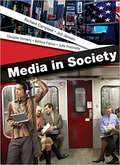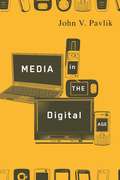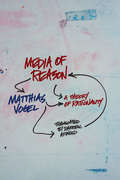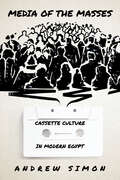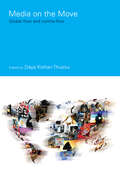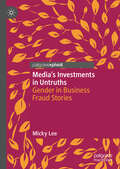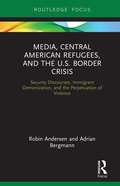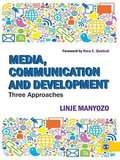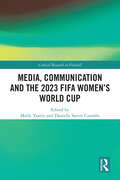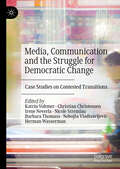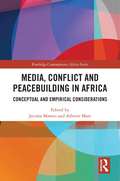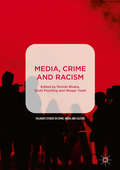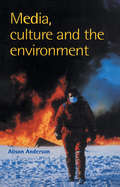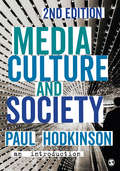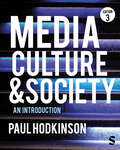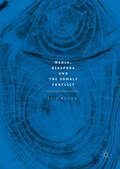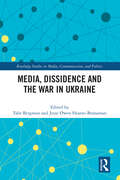- Table View
- List View
Media in Society: A Brief Introduction
by Richard Campbell Bettina Fabos Julie Frechette Douglas Gomery Joli JensenCritiquing the mass media, and the role those media play in our lives, requires a critical eye. Media in Society gives students in upper level media courses a unique narrative-based approach to media criticism, exploring the stories media tell—as well as the stories we tell about the media when we describe how it affects us. Organized thematically, Media in Society examines topics like narrative genre, entertainment culture, news, politics, and economics, emphasizing both the pleasures and pitfalls of the media narratives that surround us. Written by an esteemed team of media scholars, specifically for media students, this compact and affordable text makes a great backbone or addition to a media and society course.
Media in War and Armed Conflict: Dynamics of Conflict News Production and Dissemination (Routledge Research in Communication Studies)
by Romy FröhlichThis book focuses on the social process of conflict news production and the emergence of public discourse on war and armed conflict. Its contributions combine qualitative and quantitative approaches through interview studies and computer-assisted content analysis and apply a unique comparative and holistic approach over time, across different cycles of six conflicts in three regions of the world, and across different types of domestic, international and transnational media. In so doing, it explores the roles of public communication through traditional media, social media, strategic communication, and public relations in informing and involving national and international actors in conflict prevention, resolution and peace-keeping. It provides a key point of reference for creative, innovative, and state-of-the-art empirical research on media and armed conflict.
Media in the Digital Age
by John PavlikDigital technologies have fundamentally altered the nature and function of media in our society, reinventing age-old practices of public communication and at times circumventing traditional media and challenging its privileged role as gatekeepers of news and entertainment. Some critics believe these technologies keep the public involved in an informed discourse on matters of public importance, but it isn't clear this is happening on a large scale. Propaganda disguised as news is flourishing, and though interaction with the digital domain teaches children valuable skills, it can also expose them to grave risks. John V. Pavlik critically examines our current digital innovations-blogs, podcasting, peer-to-peer file sharing, on-demand entertainment, and the digitization of television, radio, and satellites-and their positive and negative implications. He focuses on present developments, but he also peers into the future, foreseeing a media landscape dominated by a highly fragmented, though active audience, intense media competition, and scarce advertising dollars. By embracing new technologies, however, Pavlik shows how professional journalism and media can hold on to their role as a vital information lifeline and continue to operate as the tool of a successful democracy.
Media in the Global Context: Applications and Interventions
by Emmanuel K. NgwainmbiThis book investigates ways in which global media coverage of conflicts affects the worldviews of the social and cultural values of nationals from the war regions. It identifies the cultural patterns in remote communities that have been ‘diluted’ by IT and the extent to which the changes impacted the values of the indigenes. It also describes the role that IT especially social media and broadcast media play in the understanding of war among residents in highly wired and remote communities, respectively.
Media of Reason: A Theory of Rationality (New Directions in Critical Theory)
by Matthias VogelMatthias Vogel challenges the belief, dominant in contemporary philosophy, that reason is determined solely by our discursive, linguistic abilities as communicative beings. In his view, the medium of language is not the only force of reason. Music, art, and other nonlinguistic forms of communication and understanding are also significant. Introducing an expansive theory of mind that accounts for highly sophisticated, penetrative media, Vogel advances a novel conception of rationality while freeing philosophy from its exclusive attachment to linguistics.Vogel's media of reason treats all kinds of understanding and thought, propositional and nonpropositional, as important to the processes and production of knowledge and thinking. By developing an account of rationality grounded in a new conception of media, he raises the profile of the prelinguistic and nonlinguistic dimensions of rationality and advances the Enlightenment project, buffering it against the postmodern critique that the movement fails to appreciate aesthetic experience.Guided by the work of Jürgen Habermas, Donald Davidson, and a range of media theorists, including Marshall McLuhan, Vogel rebuilds, if he does not remake, the relationship among various forms of media—books, movies, newspapers, the Internet, and television—while offering an original and exciting contribution to media theory.
Media of the Masses: Cassette Culture in Modern Egypt (Stanford Studies in Middle Eastern and Islamic Societies and Cultures)
by Andrew SimonMedia of the Masses investigates the social life of an everyday technology—the cassette tape—to offer a multisensory history of modern Egypt. Over the 1970s and 1980s, cassettes became a ubiquitous presence in Egyptian homes and stores. Audiocassette technology gave an opening to ordinary individuals, from singers to smugglers, to challenge state-controlled Egyptian media. Enabling an unprecedented number of people to participate in the creation of culture and circulation of content, cassette players and tapes soon informed broader cultural, political, and economic developments and defined "modern" Egyptian households. Drawing on a wide array of audio, visual, and textual sources that exist outside the Egyptian National Archives, Andrew Simon provides a new entry point into understanding everyday life and culture. Cassettes and cassette players, he demonstrates, did not simply join other twentieth century mass media, like records and radio; they were the media of the masses. Comprised of little more than magnetic reels in plastic cases, cassettes empowered cultural consumers to become cultural producers long before the advent of the Internet. Positioned at the productive crossroads of social history, cultural anthropology, and media and sound studies, Media of the Masses ultimately shows how the most ordinary things may yield the most surprising insights.
Media on the Move: Global Flow and Contra-Flow (Communication and Society)
by Daya Kishan ThussuMedia on the Move provides a critical analysis of the dynamics of the international flow of images and ideas. This comes at a time when the political, economic and technological contexts within which media organisations operate are becoming increasingly global. The surge in transnational traffic in media products has primarily benefited the major corporations such as Disney, AOL, Time Warner and News Corporation. However, as this book argues, new networks have emerged which buck this trend: Brazilian TV is watched in China, Indian films have a huge following in the Arab world and Al Jazeera has become a household name in the West. Combining a theoretical perspective on contra-flow of media with grounded case studies into one up-to-date and accessible volume, Media on the Move provides a much-needed guide to the globalization of media, going beyond the standard Anglo-American view of this evolving phenomenon.
Media's Investments in Untruths: Gender in Business Fraud Stories
by Micky LeeThis book examines the gendered nature of business fraud by examining media representations of four entrepreneurs (Sam Bankman-Fried, Elizabeth Holmes, Bernie Madoff, and Anna Sorokin) who swindled money from wealthy investors and everyday people. From a feminist political economic perspective, the book asks how the intersections between gender, age, socioeconomic background, and the country of origin matter in media portrayals. By examining fictionalized television shows, films, and news reports about the four fraudsters, the book considers: what kinds of &“truth&” do media texts unveil through story narrative, character development, and mise-en-scene? How were financial crimes seen to disrupt an orderly and rational market? How were fraudsters redeemed or not in media texts? This book will interest media studies scholars who examine gender, finance, and economics.
Media, Central American Refugees, and the U.S. Border Crisis: Security Discourses, Immigrant Demonization, and the Perpetuation of Violence (Routledge Focus on Media and Humanitarian Action)
by Robin Andersen Adrian BergmannThis book identifies the history, conventions, and uses of security discourses, and argues that such language and media frames distort information and mislead the public, misidentify the focus of concern, and omit narratives able to recognize the causes and solutions to humanitarian crises. What has been identified as a crisis at the border is better understood as an on-going crisis of violence, building over decades, that has forced migrants from their homes in the countries of the Northern Triangle. Authors Robin Andersen and Adrian Bergmann look back to U.S. military policies in the region and connect this legacy to the cross-border development of transnational gangs, government corruption, and on-going violence that often targetsenvironmental and legal defenders. They argue that the discourses of demonization and securitization only help perpetuate brutality in both Central America and the United States, especially in the desert borderlands of the southwest. They offer ways in which stories of migrants can be reframed within the language of justice, empathy,and humanitarianism. A compelling examination of language, media, and politics, this book is both highly contemporary and widely applicable, perfect for students and scholars of global media, political communications, and their many intersections.
Media, Communication and Development
by Linje ManyozoMedia, Communication and Development: Three Approaches explores and revisits the perspectives of Nora C Quebral, whose seminal work still remains a Magna Carta on the topic of development communication. It explores the three primary approaches--media for development, media development and participatory and community communication--which have characterised most debates in the field of media, communication and development. The book is theoretically engaging and brings in postcolonial perspectives in discussing the core concepts, but at the same time is easy-to-understand, as it illustrates the complex and multidisciplinary concepts through case studies from both the global south and the global north.
Media, Communication and Development
by Linje ManyozoMedia, Communication and Development: Three Approaches explores and revisits the perspectives of Nora C Quebral, whose seminal work still remains a Magna Carta on the topic of development communication. It explores the three primary approaches--media for development, media development and participatory and community communication--which have characterised most debates in the field of media, communication and development. The book is theoretically engaging and brings in postcolonial perspectives in discussing the core concepts, but at the same time is easy-to-understand, as it illustrates the complex and multidisciplinary concepts through case studies from both the global south and the global north.
Media, Communication and the 2023 FIFA Women’s World Cup (Critical Research in Football)
by Danielle Sarver Coombs Molly YanityThis book takes a close look at the themes of media and communication in the context of the 2023 FIFA Women’s World Cup, one of the most attended women’s sporting events in history. Featuring the work of leading researchers from around the world, the book examines how the tournament was represented through traditional, digital and social forms of media, and considers how an analysis of media and communications in, around and after the tournament can help to illuminate our understanding of key themes in the study of women and sport. The book presents a series of important and fascinating cases - including media representation of Muslim women at the tournament; analysis of media reaction to USWNT results; the role of podcasts in the coverage of the tournament, and a social media analysis of sexual violence toward women athletes at the WWC – that together form a multi-layered picture of a seminal event in the history of women’s sport. This book is vital reading for anybody with an interest in women’s sport, gender and sport, the sociology of sport, media studies, communication studies, event studies or sport business and management.
Media, Communication and the Struggle for Democratic Change: Case Studies on Contested Transitions
by Katrin Voltmer Christian Christensen Herman Wasserman Nicole Stremlau Barbara Thomass Irene Neverla Nebojša VladisavljevićThis book investigates the role of media and communication in processes of democratization in different political and cultural contexts. Struggles for democratic change are periods of intense contest over the transformation of citizenship and the reconfiguration of political power. These democratization conflicts are played out within an increasingly complex media ecology where traditional modes of communication merge with new digital networks, thus bringing about multiple platforms for journalists and political actors to promote and contest competing definitions of reality. The volume draws on extensive case study research in South Africa, Kenya, Egypt and Serbia to highlight the ambivalent role of the media as force for democratic change, citizen empowerment, and accountability, as well as driver of polarization, radicalization and manipulation.
Media, Conflict and Peacebuilding in Africa: Conceptual and Empirical Considerations (Routledge Contemporary Africa)
by Jacinta MaweuThis book explores the role and place of popular, traditional and digital media platforms in the mediatization, representation and performance of various conflicts and peacebuilding interventions in the African context. The role of the media in conflict is often depicted as either ‘good’ (as symbolized by peace journalism) and ‘bad’ (as exemplified by war journalism), but this book moves beyond this binary to highlight the ‘in-between’ role that the media often plays in times of conflict. The volume does not only focus on the relationship between mass media, conflict and peacebuilding processes but it broadens its scope by critically analysing the dynamic and emergent roles of popular and digital media platforms in a continent where the semi-literate and oral communities still rely heavily on popular communication platforms to get news and information. Whilst social media platforms have been hailed for their assumed democratic and digital dividends, this book does not only focus on these positive aspects but also shines a light on dark forms of participation which are fuelling racial, gender, ethnic, political and religious conflicts in highly polarized and stratified societies. Highlighting the many ways in which traditional, digital and popular media can be used to both escalate conflicts and promote peacebuilding, this volume will be a useful resource for students, researchers and civil society groups interested in peace and conflict studies, journalism and media studies in different contexts within Africa.
Media, Crime and Racism (Palgrave Studies In Crime, Media And Culture Ser.)
by Monish Bhatia Scott Poynting Waqas TufailMedia, Crime and Racism draws together contributions from scholars at the leading edge of their field across three continents to present contemporary and longstanding debates exploring the roles played by media and the state in racialising crime and criminalising racialised minorities. Comprised of empirically rich accounts and theoretically informed analysis, this dynamic text offers readers a critical and in-depth examination of contemporary social and criminal justice issues as they pertain to racialised minorities and the media. Chapters demonstrate the myriad ways in which racialised ‘others’ experience demonisation, exclusion, racist abuse and violence licensed – and often induced – by the state and the media. Together, they also offer original and nuanced analysis of how these processes can be experienced differently dependent on geography, political context and local resistance. This collection critically reflects on a number of globally significant topics including the vilification of Muslim minorities, the portrayal of the refugee ‘crisis’ and the representations and resistance of Indigenous and Black communities. This volume demonstrates that processes of racialisation and criminalisation in media and the state cannot be understood without reference to how they are underscored and inflected by gender and power. Above all, the contributors to this volume demonstrate the resistance of racialised minorities in localised contexts across the globe: against racialisation and criminalisation and in pursuit of racial justice.
Media, Culture And The Environment (Communications, Media And Culture Ser.)
by Alison Anderson University of Plymouth. Anderson, AlisonThis book is intended for final year undergraduates and postgraduates in cultural and media studies, as well as postgraduate and academic researchers. Courses on culture and the media within sociology, environmental studies, human geography and politics.
Media, Culture and Society
by Paul HodkinsonThe omnipresence of media in our lives would have been unthinkable just a few decades ago. Where the average family might once have had a single black and white console TV marooned in its living room, with exactly three channels to choose from, we now live in a world where we are literally surrounded by screens of every shape and size, some small enough to carry with us everywhere we go. The innumerable voices clamoring for our attention create a cocoon of white noise within which we are all enveloped without exception, for while we may choose to block out some of the screens, we can never block out the impact they have on our culture as a whole. Attempting to elucidate the endless ways we are both shaped by and reflected within the media is a colossal task, but Hodkinson proves up to it as he coolly and objectively dissects his subject from dozens of different angles using a taut and lucid prose style. The book is divided into three main sections: elements of media; media, power and control; and media, identity and culture. This is a vast amount of territory to cover and it would be easy for an author to get lost in a fog of abstract metaphor, but Hodkinson never drifts off course, ably acquitting himself to the reader as a steady, sharp-eyed guide to our strange new media world. Annotation ©2011 Book News, Inc. , Portland, OR (booknews. com)
Media, Culture and Society in Iran: Living with Globalization and the Islamic State (Iranian Studies)
by Mehdi SematiBy exploring topics such as the Internet, print press, advertising, satellite television, video, rock music, literature, cinema, gender, religious intellectuals, and secularism, this unique and wide-ranging volume explains Iran as a complex society that has successfully managed to negotiate and embody the tensions of tradition and modernity, democracy and theocracy, isolation and globalization, and other such cultural-political dynamics that escape the explanatory and analytical powers of all-too-familiar binary relations. Featuring contributions from among the best-known and emerging scholars on Iranian media, culture, society, and politics, this volume uncovers how the existing perspectives on post-revolutionary Iranian society have failed to appreciate the complexity, the paradoxes and the contradictions that characterize life in contemporary Iran, resulting in a general failure to explain and to anticipate its contemporary social and political transformations.
Media, Culture and Society in Malaysia (Routledge Malaysian Studies Series)
by Yeoh Seng GuanThis book presents a comprehensive, full-length analysis of the uses of media and communication technologies by different social actors in Malaysia. Unlike other studies of the media in Malaysia which concentrate on "political economy" or "freedom of the media" approaches, this book focuses on the ways in which different media forms have constituted cultural practices and power relations amongst particular audiences and publics. It also examines the ways in which technologies of varying scales and range have been appropriated for various subaltern purposes and counter-hegemonic agendas. Drawing upon recent case studies on the deployment of different media – including mainstream and independent films, television programming, black metal music, community rituals, political advertising, the internet, and artistic visual installations – it provides valuable insights into the complex, vibrant ways in which these different media forms have negotiated with the dominant cultural representations of Malaysian society. The book makes an important contribution to the emergent disciplines of media studies and cultural studies in Malaysia.
Media, Culture and Society: An Introduction
by Paul Hodkinson'In his beautifully balanced, clear and broad-ranging account of a fast-changing field, Paul Hodkinson has successfully brought together myriad perspectives with which to critically analyse today's media culture and media society.'– Sonia Livingstone, Professor of Media & Communication, LSE Paul Hodkinson's bestseller is back, once again exploring the concepts and complexities of the media in an accessible, balanced and engaging style. Additions to the Second Edition include: A new chapter on advertising and sponsorship Extensive revision and updating throughout all chapters New material on technologies, censorship, online news, fan cultures and representations of poverty Greater emphasis on and examples of digital, interactive and mobile media throughout Fully reworked chapter on media, community and difference Up-to-date examples covering everything from social media, contemporary advertising, news events and mobile technologies, to representations of class, ethnicity and gender. Combining a critical survey of the field with a finely judged assessment of cutting-edge developments, this Second Edition cements its reputation as the must-have text for any undergraduate student studying media, culture and society.
Media, Culture and Society: An Introduction
by Paul Hodkinson'In his beautifully balanced, clear and broad-ranging account of a fast-changing field, Paul Hodkinson has successfully brought together myriad perspectives with which to critically analyse today's media culture and media society.'– Sonia Livingstone, Professor of Media & Communication, LSE Paul Hodkinson's bestseller is back, once again exploring the concepts and complexities of the media in an accessible, balanced and engaging style. Additions to the Second Edition include: A new chapter on advertising and sponsorship Extensive revision and updating throughout all chapters New material on technologies, censorship, online news, fan cultures and representations of poverty Greater emphasis on and examples of digital, interactive and mobile media throughout Fully reworked chapter on media, community and difference Up-to-date examples covering everything from social media, contemporary advertising, news events and mobile technologies, to representations of class, ethnicity and gender. Combining a critical survey of the field with a finely judged assessment of cutting-edge developments, this Second Edition cements its reputation as the must-have text for any undergraduate student studying media, culture and society.
Media, Culture and Society: An Introduction
by Paul HodkinsonAs digital media come to saturate more and more of our societies, what benefits and challenges do they bring? Who holds power in contemporary media industries, and do they have our best interests at heart? What role do media play in our cultural identities and the relations between communities? How much control do media users have over the role of platforms, algorithms and data in their lives? Media increasingly dominate our social and cultural worlds, affecting issues of power, politics, knowledge, identity, and everyday life. But what are the implications of the mediatisation of contemporary life, and how should we make sense of it? In this fully updated and revised edition of his bestselling textbook, Paul Hodkinson explores the social and cultural significance of media in the age of digital platforms. Encompassing media technologies, industries, texts and users, and combining coverage of classic theories with extensive new material on platforms, social media, datafication and more, this book will equip you to navigate the fast-moving field of media and communication studies. Media, Culture and Society provides an essential overview for students studying introductory media modules, as well as depth for those further into their media degree.
Media, Culture and Society: An Introduction
by Paul HodkinsonAs digital media come to saturate more and more of our societies, what benefits and challenges do they bring? Who holds power in contemporary media industries, and do they have our best interests at heart? What role do media play in our cultural identities and the relations between communities? How much control do media users have over the role of platforms, algorithms and data in their lives? Media increasingly dominate our social and cultural worlds, affecting issues of power, politics, knowledge, identity, and everyday life. But what are the implications of the mediatisation of contemporary life, and how should we make sense of it? In this fully updated and revised edition of his bestselling textbook, Paul Hodkinson explores the social and cultural significance of media in the age of digital platforms. Encompassing media technologies, industries, texts and users, and combining coverage of classic theories with extensive new material on platforms, social media, datafication and more, this book will equip you to navigate the fast-moving field of media and communication studies. Media, Culture and Society provides an essential overview for students studying introductory media modules, as well as depth for those further into their media degree.
Media, Diaspora and the Somali Conflict
by Idil OsmanThis book illustrates how diasporic media can re-create conflict by transporting conflict dynamics and manifesting them back in to diaspora communities. Media, Diaspora and Conflict demonstrates a previously overlooked complexity in diasporic media by using the Somali conflict as a case study to indicate how the media explores conflict in respective homelands, in addition to revealing its participatory role in transnationalising conflicts. By illustrating the familiar narratives associated with diasporic media and utilising a combination of Somali websites and television, focus groups with diaspora community members and interviews with journalists and producers, the potentials and restrictions of diasporic media and how it relates to homelands in conflict are explored.
Media, Dissidence and the War in Ukraine (Routledge Studies in Media, Communication, and Politics)
by Tabe Bergman Hearns-Branaman, Jesse OwenThis volume examines the global media coverage of the armed conflict in Ukraine, focusing on the marginalization of dissident perspectives in the West and the information quality and diversity on social media.Along with presenting original, empirical studies on how mainstream media in countries as diverse as Israel, the Czech Republic, Ghana, and the Netherlands have covered the conflict between NATO and Russia since 2022, this book sheds light on the role of the state and the media in policing the boundaries of permissible thought on the conflict in the West, as well as in Russia and Ukraine. It also delves into the war’s representation on prominent social media platforms.Written by a diverse group of international researchers, this multifaceted volume offers new perspectives and insights on the reporting of the ongoing conflict. It will interest scholars of international communication and media, foreign policy and international politics, war and conflict, content analysis, and journalism.
